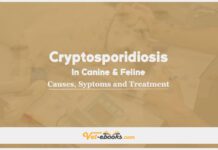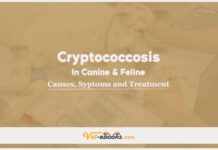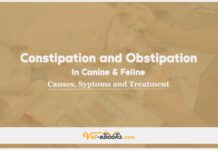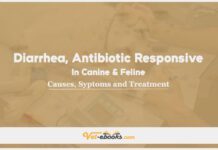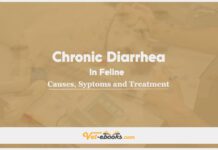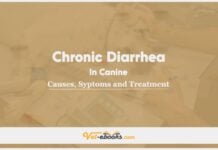Acute Vomiting In Canine and Feline: Causes, Symptoms and Treatment
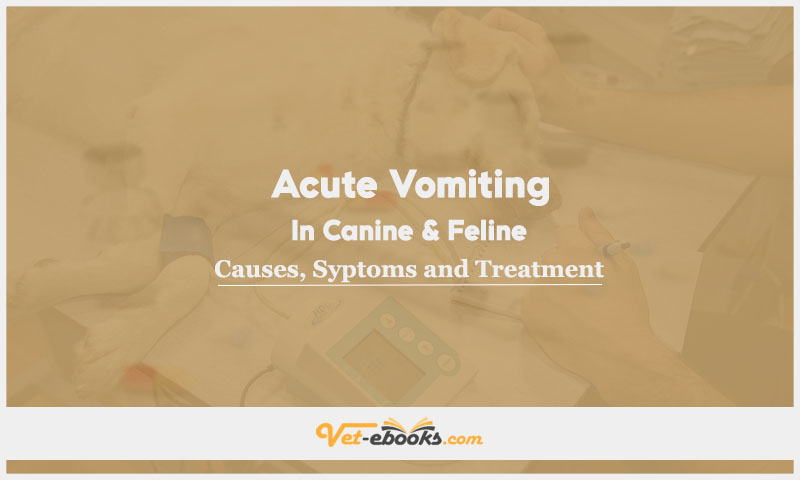
Contents
hide
Overview
The expelling of stomach contents for a short period, lasting less than 5-7 days at irregular intervals.
Causes of Acute Vomiting In Canine and Feline
Causes
- Hepatobiliary illness, renal disease, pancreatitis, and neoplasia.
- CNS disorders and cardiac ailments.
- Endocrine dysfunctions such as hypoadrenocorticism, hyperthyroidism, and diabetic ketoacidosis.
- Respiratory diseases, peritonitis, and sepsis.
- Congenital or genetic causes, such as hiatal hernia.
- Parasitic, protozoal, viral (parvovirus, canine distemper virus, and coronavirus), fungal, and bacterial (Campylobacter and Salmonella).
- Acute gastritis or gastroenteritis.
- Acute hemorrhagic diarrhea syndrome.
- Intussusception, foreign body, an obstructive mass such as a granuloma, neoplasia, pyloric hypertrophy, or trichobezoar, and gastric or mesenteric volvulus.
- Medications such as α2 agonists, antibiotics, apomorphine, chemotherapeutic agents, methimazole, nonsteroidal anti-inflammatory drugs (NSAIDs), and opioids.
- Toxins such as corrosive substances and heavy metals.
- Adenocarcinoma, lymphoma, leiomyoma, gastrointestinal stromal tumor, and mast cell tumor in cats.
- Gastric and duodenal ulcers.
Risk factors
- An abrupt alteration in diet or a dietary indiscretion.
- Numerous pharmaceutical substances.
- Geographic distribution effect.
Pathogenesis of Acute Vomiting In Canine and Feline
- Vomiting is initiated by the vomiting center in the medulla.
- This reflex is triggered by gastric/duodenal mucosal irritation, gastric/duodenal distention, or stimulation of the chemoreceptor trigger zone (CRTZ).
- The vomiting center is stimulated by mucosal irritation or gastric or duodenal distention through the activation of sympathetic and vagal afferent innervation.
- Anti-peristaltic waves exert pressure on the intestinal contents, causing them to move in the opposite direction towards the duodenum.
- Distention of the intestines emerges as the primary stimulus for initiating the vomiting reflex.
- The CRTZ stimulates the vomiting center by activating certain receptors or via vestibular input.
- Receptors in this process include α2, D2, H1, M1, NK1, and 5HT3.
- The cerebral cortex and vestibular apparatus activate the vomiting center.
- The vomiting center triggers an autonomic motor response by activating spinal nerves connected to the diaphragmatic and abdominal muscles.
- It activates cranial nerves 5, 7, 9, 10, and 12, which are responsible for controlling the upper gastrointestinal tract.
- The reflex involves taking a deep breath, opening the upper esophageal sphincter, closing the glottis, contracting the diaphragm and abdominal muscles forcefully, and relaxing the lower esophageal sphincter.
- These coordinated activities result in the expulsion of the contents.
Symptoms (History & Physical Examination) of Acute Vomiting In Canine and Feline
History
- Differentiate between vomiting and regurgitation.
- Investigate dietary indiscretion, the ingestion of foreign bodies, and the use of drugs.
- Hypersalivation and nausea.
- Vomiting can manifest in different degrees, frequencies, and intensities.
- Severity, frequency, and amounts of vomiting.
- Different levels of activity, ranging from typical to sluggish.
- Hematemesis may be observed.
Physical Examination
- Dehydration/hypovolemia, cranial abdominal discomfort, nausea, presence of fluid-gas interface upon intestinal examination, and enhanced borborygmi.
- Inspection of the sublingual region for the presence of anchored linear foreign bodies.
- Abdominal palpation to assess the presence of mechanical obstruction.
- A rectal examination to assess the presence of melena or concomitant diarrhea.
Diagnosis of Acute Vomiting In Canine and Feline
1- From History and Physical Examination
2- Diagnostic Procedures
CBC/BIOCHEMISTRY/URINALYSIS
- In cases of non severe vomiting, the hemogram, biochemical profile, and urinalysis do not exhibit any notable abnormalities, unless the animal is dehydrated.
- In cases of severe stomach ulcers and bleeding, anemia and panhypoproteinemia are present.
- Elevated PCV and total protein levels are symptoms of hemoconcentration.
- The presence of a stress leukogram may be observed.
- In certain instances, the presence of infectious or inflammatory factors lead to the manifestation of an inflammatory leukogram.
- Acute hepatopathies are characterized by increased levels of liver enzymes and blood bilirubin.
- Pancreatitis may present with increased levels of lipase, amylase, and liver enzymes.
- Hyponatremia, hyperkalemia, hypoglycemia, and azotemia may indicate hypoadrenocorticism.
- Ketoacidotic diabetes mellitus is characterized by hyperglycemia, glucosuria, and ketonuria.
- Hypochloremic metabolic acidosis may indicate stomach outflow blockage.
OTHER LABORATORY TESTS
Aspartate amino acid assay, adrenocorticotropic hormone (ACTH) stimulation testing for hypoadrenocorticism, and canine pancreatic lipase immunoreactivity (cPL) or feline pancreatic lipase immunoreactivity (fPL) testing for pancreatitis.
Imaging:
Radiography:
- Do not show anything clear, but sometimes they show things like radiodense foreign bodies, segmental ileus, or gastric distension that could mean volvulus or outflow obstruction.
- Pancreatitis or peritonitis result in a loss of serosal detail, characterized by a “ground glass” appearance.
- The identification of a mass effect or haziness in the right cranial quadrant or the persistence of gas in the descending duodenum may be indicators of pancreatitis.
- Contrast radiography to assess the presence of radiolucent foreign bodies, blockage, intussusception, or volvulus.
Ultrasonography:
To visualize various conditions such as blockage, intussusception, lymphadenopathy, tumors, or pancreatitis.
3- Differential Diagnosis
Regurgitation may be erroneously identified as vomiting.
- In case of vomiting, prodromal symptoms such as nausea with hypersalivation, retching, and abdominal contractions.
- In case of regurgitation, There is no prodromal nausea, and the ejection of food is in a passive nature.
- Regurgitation might be a consequence of vomiting through esophagitis.
- It is important to establish chronology when both symptoms are observed.
- In felines, regurgitation may be mistaken for coughing.
- Coughing entails the extension of the neck and elbows.
- Physical examination findings may differentiate.
Treatment of Acute Vomiting In Canine and Feline
General
- Patients should be hospitalized in cases of acute vomiting.
- The first line of treatment for patients who experience frequent vomiting episodes is keeping them NPO and administering intravenous crystalloid fluids.
Medications:
- Anti-emetics for patients experiencing severe vomiting.
- Phenothiazine derivatives, such as chlorpromazine, act on the chemoreceptor trigger zone (CTZ) and emetic center at a dose of 0.5mg/kg subcutaneously every 8 hours for dogs and cats.
- Metoclopramide is a dopamine antagonist and motility modifier that acts on the CTZ and local receptors in the gut at a dose of 0.2-0.5mg/kg orally or subcutaneously every 6-8 hours or as a constant rate infusion of 1-2mg/kg/day.
- H1-receptor antagonists used for motion sickness in dogs, such as diphenhydramine at a dose of 2-4mg/kg orally or intramuscularly every 6-8 hours.
- Maropitant, a neurokinin-1antagonist, is used in dogs and cats at a dose of 1mg/kg subcutaneously or intravenously every 24 hours, or 2mg/kg orally every 24 hours.
- Patients with ulceration may be prescribed H2-receptor antagonists, such as ranitidine and famotidine.
- Omeprazole at a dose of 0.7-1mg/kg administered orally every 12-24 hours for dogs and cats.
- Gastric mucosal protectants such as sucralfate at a dose of 250mg orally every 6-12 hours for cats and 250-1000mg orally every 6-12 hours for dogs, can be dissolved into a slurry and administered on an empty stomach.
- Antibiotics, such as ampicillin or enrofloxacin, in case of fever or mucosal damage.
Some Notes:
- Use caution when administering phenothiazines to patients who are dehydrated.
- Do not use anticholinergic medications because they induce gastric atony and intestinal ileus, which may further aggravate the symptoms of vomiting.
- It is not recommended to administer prokinetics, such as metoclopramide and cisapride, to patients who have gastrointestinal blockage.
- The administration of maropitant should be approached cautiously in those with hepatic illness.
- Anti-emetics should be used with caution due to their potential to inhibit vomiting, obscure the progression of sickness, or hinder the ability to assess the effectiveness of primary treatment.
- The concurrent use of anticholinergics and opioids has the potential to counteract the therapeutic effects of metoclopramide.
Tip
Do You Want To Increase Your Veterinary Knowledge and Practical Skills?
You Can Now Browse and Download +3000 Books For Veterinary Professionals & Students Online.
Download Veterinary Books

